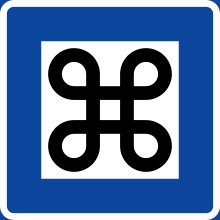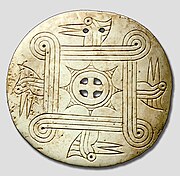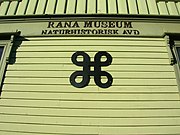สี่เหลี่ยมวน


สี่เหลี่ยมวน (อังกฤษ: looped square, สัญลักษณ์:⌘) เป็นสัญลักษณ์ที่มีรูปสี่เหลี่ยมที่มีรูปวนตรงมุมข้างนอก บางครั้งมีชื่อว่า ป้ายสถานที่ที่น่าสนใจ[1] ซึ่งเป็นป้ายข้อมูลที่เริ่มใช้งานครั้งแรกในประเทศฟินแลนด์เมื่อคริสต์ทศวรรษ 1950 แล้วค่อยกระจ่ายไปทั่วกลุ่มประเทศนอร์ดิกในคริสต์ทศวรรษ 1960[2] บางครั้ง สัญลักษณ์นี้มีอีกชื่อว่า แขนของนักบุญยอห์น หรือ กางเขนของนักบุญฮันเนส (สวีเดน: sankthanskors; เดนมาร์ก: johanneskors; ฟินแลนด์: hannunvaakuna) บ่วงกอร์กอน และ สัญลักษณ์คำสั่ง เนื่องจากมีการใช้สัญลักษณ์นี้บนแป้นคำสั่งในแป้นพิมพ์คอมพิวเตอร์ของแอปเปิล
สัญลักษณ์นี้เป็นสัญลักษณ์ในอดีตของบางวัฒนธรรม และยังใช้งานจนถึงปัจจุบัน ซึ่งอยู่ในกลุ่มสัญลักษณ์ วัลคนุต ในนอร์เวย์[3]
การใช้งานในสมัยก่อน
[แก้]สัญลักษณ์นี้ปรากฏบนวัตถุโบราณหลายแห่งในยุโรปเหนือ โดยสัญลักษณ์ที่โด่งดังปรากฏบนภาพหินจากฮอบลิงบู กอตลันด์ ประเทศสวีเดน ซึ่งสร้างขึ้นระหว่าง ค.ศ. 400 ถึง 600[4] สัญลักษณ์นี้มีความคล้ายกับตรามุทราศาสตร์ที่มีชื่อว่าเงื่อนโบเวน[5]
ในฟินแลนด์ จะมีการทาสีหรือสลักสัญลักษณ์นี้ในบ้านกับยุ้งฉาง และเครื่องใช้ในบ้านเช่นเครื่องใช้สำหรับโต๊ะอาหาร เพื่อปกป้องมันและเจ้าของจากวิญญาณอันชั่วร้ายและโชคร้าย ตัวอย่างที่เก่าแก่ที่สุดเท่าที่ยังเหลืออยู่คือสกีอายุ 1000 ปี (ฟินแลนด์ก่อนสมัยศาสนาคริสต์) ที่ตกแต่งด้วยสัญลักษณ์นี้[6][7]
สี่เหลี่ยมวนยังสามารถพบได้บนสิ่งประดิษฐ์ของวัฒนธรรมมิสซิสซิปปีในภาคตะวันออกเฉียงใต้ของสหรัฐ[8]
การใช้งานในปัจจุบัน
[แก้]
ในปัจจุบัน สัญลักษณ์มักใช้เป็นเครื่องชี้บอกที่ตั้งสิ่งที่น่าสนใจทางวัฒนธรรม โดยเริ่มต้นที่ฟินแลนด์ในคริสต์ทศวรรษ 1950 และขยายไปทั่วกลุ่มประเทศนอร์ดิกในคริสต์ทศวรรษ 1960[2] มีความเห็นในสมัยใหม่ว่ามีการใช้สัญลักษณ์นี้เพราะมันดูคล้ายกับภาพถ่ายทางอากาศของปราสาทบอร์กฮอล์ม[9]
ต่อมา สัญลักษณ์นี้เริ่มเป็นที่รู้จักทั่วโลกผ่านการคอมพิวเตอร์ โดยถูกใช้เป็นลัญลักษณ์แป้นคำสั่งบนแป้นพิมพ์ของแอปเปิล[10] เช่นเดียวกันกับสัญลักษณ์ซูเปอร์คีย์บนเอเลอเมนทารีโอเอส[11]
รหัส
[แก้]ในยูนิโคด สัญลักษณ์นี้ตั้งอยู่ใน U+2318 ⌘ place of interest sign (HTML ⌘) ของบล็อก Miscellaneous Technical
แกลเลอรี่
[แก้]
|
อ้างอิง
[แก้]- ↑ "Miscellaneous Technical – Range: 2300-23FF" (PDF). Unicode Consortium.
- ↑ 2.0 2.1 "Riksantikvarieämbetets historia". raa.se (ภาษาสวีเดน). Riksantikvarieämbetet - Swedish National Heritage Board. สืบค้นเมื่อ 16 March 2018.
- ↑ Municipal arms for Lødingen, blazoned in the Norwegian Royal Decree of 11 May 1984, quoted in Hans Cappelen og Knut Johannessen: Norske kommunevåpen, Oslo 1987, page 197. The term is also used in Anders Bjønnes: Segltegninger fra hyllingene i Norge 1591 og 1610, Oslo 2010, pages 64–65.
- ↑ "The Picture Stone from Havor in Hablingbo". Länsmuseet på Gotland. คลังข้อมูลเก่าเก็บจากแหล่งเดิมเมื่อ 13 September 2008.
- ↑ Parker, James (1894). A Glossary of Terms Used in Heraldry: Cord. สืบค้นเมื่อ 18 March 2007.
- ↑ Talve, Ilmar (1990). Suomen kansankulttuuri (ภาษาฟินแลนด์). ISBN 951-717-553-1.
- ↑ Department of Archaeology. "Ski fragment". Nat'l Board of Antiquities (ภาษาฟินแลนด์). Helsinki: Finnish Museums Online. p. KM9908:1. คลังข้อมูลเก่าเก็บจากแหล่งเดิมเมื่อ 3 December 2013.
- ↑ C. Andrew Buchner (2010). "Cox Mound Gorget". Tennessee Encyclopedia. Tennessee Historical Society. สืบค้นเมื่อ 9 May 2013.
The Cox Mound, or Woodpecker, gorget style is a … symbol of Tennessee's prehistoric inhabitants. A gorget was a pendant worn around the neck as a badge of rank... thought to be symbolic of both earthly and supernatural powers; A.D. 1250–1450.
- ↑ Kare, Susan. "Susan Kare, Iconographer (EG8)". Vimeo.com. สืบค้นเมื่อ 25 June 2014.
- ↑ Dan Frommer (2 July 2011). "What does Splat mean?". SplatF. Say Media. สืบค้นเมื่อ 9 May 2013.
Splat refers to the key on a Mac keyboard that's officially called the Command key. Some old-school Mac nerds — my father included — call it the "splat" key, because the symbol sort of looks like something that went "splat". The symbol itself, also known as Saint John’s Arms or the "place of interest sign"... is often seen in Northern Europe.
- ↑ Why the Looped Square (⌘) Symbol?. Medium. 1 March 2018.
แหล่งข้อมูลอื่น
[แก้] วิกิมีเดียคอมมอนส์มีสื่อเกี่ยวกับ สี่เหลี่ยมวน
วิกิมีเดียคอมมอนส์มีสื่อเกี่ยวกับ สี่เหลี่ยมวน







